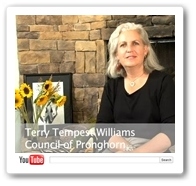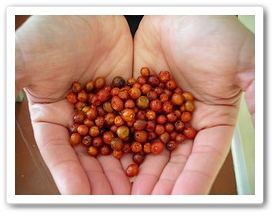Posted - 03/01/2011 Terry Tempest Williams of Council of Pronghorn — 2010 Convening Interview

Terry Tempest Williams of the activist art installation, Council of Pronghorn, gracefully articulates what changed for her at the 2010 Invoking the Pause Convening.
“What has surprised me is the infusion of hope. I did not realize what a deficit I was holding.
Posted - 02/28/2011 Nina Wise Improvisational FULL Performance – Invoking the Pause Convening

Invoking the Pause was delighted to feature the artistic activism of Nina Wise during the 2010 Convening of Grant Partners.
To compile her brilliant, witty and hilarious improvisational
performance, she sat in on the various sessions for the convening as a
participant. This fun piece of her work is sure to inspire and tickle
you pink at the same time!
Posted - 02/28/2011 Right Brain Metrics of Success: Synchronicity

Recently, at the annual The Philanthropy Workshop West alumni conference, I was asked to speak about Invoking The Pause (ITP). In preparing my remarks and thinking about ways to discuss the impacts and progress of ITP for the presentation, I realized that I needed to create some new, non-traditional metrics.
So I coined 2 new terms, ROR (Return on Relationship) and Collateral Delight.
Posted - 02/25/2011 Windowfarms featured in Martha Stewart Magazine “Grow Your Own Hydroponic Garden”
 The October 2010 issue of Martha Stewart Magazine featured Windowfarms’ Hydroponic Garden Kits, an exciting advancement in bringing these climate-friendly indoor gardens into the mainstream!
The October 2010 issue of Martha Stewart Magazine featured Windowfarms’ Hydroponic Garden Kits, an exciting advancement in bringing these climate-friendly indoor gardens into the mainstream!
Article excerpt: “There is no substitute for fresh, homegrown produce, but what if you don’t have any outdoor space? Hydroponic gardening is an easy way to grow edible plants in small spaces year round.
“Instead of using soil, roots are suspended in specially formulated clay pellets and are tightly compacted so you can hang dozens in your window. You can either make your own hydroponic garden or you can purchase a kit from Windowfarms.â€
Posted - 02/15/2011 Flavors Without Borders/Sabores Sin Fronteras Feeding the Future: Smart Ranching and the Southwest Center

Folklorist Maribel Alvarez and ethnobotanist Gary Paul Nabhan of Taco Diplomacy are giving a lot of thought to the future of a traditional local food, the beef taco. It’s part of their “Flavors Without Borders/Sabores Sin Fronteras†project, which looks at the shared culinary traditions of the Southwest, including Northern Mexico, Southern Arizona and New Mexico.
Click here to read the full article and view the video: Feeding the Future: Smart Ranching and the Southwest Center | The University of Arizona, Tucson, Arizona.
–Taco Diplomacy, a project of Sabores Sin Fronteras, is a 2009 Invoking the Pause Grant Partner.
Posted - 02/12/2011 The State of Southwestern Foodsheds: A Report by Taco Diplomacy’s Gary Nabhan and Regina Fitzsimmons
Within the last decade, tremendous changes have occurred in America’s food production, distribution and consumption.
Just take a second to look back to what you ate and what you could not
afford to eat at the turn of the millennium, in January of 2000.
Nowhere is this change more evident than in the food-
producing landscapes in the Southwestern borderland states of Arizona
and New Mexico, where both positive and detrimental changes have
occurred. These changes not only affect human health, but the health of land as well.
» Read More
Posted - 02/09/2011 The Future of Secure Energy Eban Goodstein of C2C speaks to 1,000 GM Employees
 Eban Goodstein is the Director of the Bard Center for Environmental Policy and Executive Director of C2C and National Teach-In (a 2008 ITP Grant Partner).
On November 18, 2010 he was asked to participate in a press conference
announcing a major new green initiative by General Motors.
Eban Goodstein is the Director of the Bard Center for Environmental Policy and Executive Director of C2C and National Teach-In (a 2008 ITP Grant Partner).
On November 18, 2010 he was asked to participate in a press conference
announcing a major new green initiative by General Motors.Chevy’s $40 million project aims to reduce 8 million metric tons of carbon over the next few years through energy efficiency and renewable energy projects in communities across the country.
» Read More
Posted - 01/26/2011 Pepperwood Preserve presents: “Future Climate Scenarios” A Presentation to the California Department of Fish and Game
 Lisa Micheli and Morgan Kennedy of Pepperwood Preserve gave a recent presentation entitled, “Downscaling future climate scenarios to the watershed scale: a North San Francisco Bay Estuary case study†at the California Department of Fish and Game’s recent workshop entitled, “Bridging the Gap: Downscaling Climate Models to Inform Management Actions.â€
Lisa Micheli and Morgan Kennedy of Pepperwood Preserve gave a recent presentation entitled, “Downscaling future climate scenarios to the watershed scale: a North San Francisco Bay Estuary case study†at the California Department of Fish and Game’s recent workshop entitled, “Bridging the Gap: Downscaling Climate Models to Inform Management Actions.â€Summary of the presentation:
Analyses from fine-scale modeling on the basis of 4 scenarios indicate:
• Air temperature will increase, precipitation is variable
• Ecosystems will become more stressed due to increased CWD
• Impacts are variable across the region
• Water availability is uncertain across the region
• Local “resilient†areas may maintain vegetation populations despite stresses and declines
» Read More
Posted - 01/18/2011 Arizona’s Food Insecurity: Gary Nahban Interview The Taco Diplomacy Executive Director is interviewed by Arizona Public Radio
Former NAU and current U of A researcher Gary Nabhan edited the study, called the “State of Southwestern Food Sheds.†He told KNAU’s Daniel Kraker that Arizona’s food security has never been more vulnerable and explains the impact this has on our children and future generations.
Find out why 25% of America’s ranch and farmland loss in the past 25 years has occurred in the four states bordering Mexico.
Click here to listen to the radio interview.
- All
- #ZeroBy2050
- 10Power
- 350 Seattle
- 36.5
- ANHE
- ARC-KE:i
- Al Gore
- Alicia Escott
- American Resilience Project
- Anjali Nayar
- Anthony Myint
- As You Sow
- At the Water's Edge
- Bard Center for Environmental Policy
- Beka Economopoulos
- Biomimicry Collaborative
- Bioneers
- Black Permaculture Network
- Blossoming Possibilities
- Blue Heart Labs
- Bodhi Garrett
- Britta Riley
- Bureau of Linguistical Reality
- C2C(Change 2 Climate)
- CELI
- COP21
- COP22
- California Foodways
- California Institute for Rural Studies
- Carbon Shock
- Casey Beck
- Catalogue of Extinct Experience
- Cathedral of St. John the Divine
- Center for Investigative Reporting
- Change the Bulb
- Chris Desser
- CityLab7
- Clean Energy Leadership Institute
- Climate Change
- Climate Science Alliance
- Climate Solutions Group
- CoClimate
- Convening 2010
- Coronavirus
- Council of Pronghorn
- Daily Acts
- Dancing Earth
- Dancing Without Borders
- Dr. Renee Lertzman
- Dream Rider Productions
- DreamRider Productions
- Duke University
- E2
- Earth Guardians
- Earthseed Consulting
- Eban Goodstein
- Eve Mosher
- Faith Kearns
- GAIA
- Gary Nabhan
- General
- Global Climate Action Summit
- Grant Partner Gathering
- Grant Partner Spotlight
- Grant Partners
- Grant Proposal Application
- Grants
- Happening
- Heidi Quante
- HighWaterLine
- Human Impacts Institute
- Impact Experience
- Impact Hours
- Invoking the Pause
- Joshua Fouts
- KALW
- KQED
- Kelly McVicker
- Kiss The Ground
- Libby Modern
- Lien Tran
- Lindley Mease
- Lisa Micheli
- Lisa Morehouse
- Magalie Bonneau
- Maggie Kaplan
- Mark Hertsgaard
- Mark Schapiro
- McDonalds
- Monica Wilson
- Morgan Curtis
- Natural History Museum
- Newsweek
- Nicole Heller
- Nicole Lederer
- Nina Simons
- Nina Wise
- Optimist Daily
- Pandora Thomas
- Paris COP21
- Pepperwood Preserve
- Peter Cunningham
- Planet Protector Academy
- Planet Protectors
- Post Pause
- Power Shift Network
- Presidio Graduate School
- Psych Alive
- Rainforest Connection
- Rebecca Patton
- Reinhard Hohlwein
- Rulan Tangen
- SPM3
- Sandra Kwak
- Sarah Cameron Sunde
- Science House Foundation
- Seeding Possibilities
- Seeds of Resistance
- Starbucks
- Stephen Antupit
- Sun Valley Forum
- SustainUS
- TIMBY
- Taco Diplomacy
- Tara DePorte
- Tensorflow
- Terry Tempest Williams
- The Arctic Cycle
- The Natural History Museum
- The Optimist Daily
- The Organic Life
- The Perennial
- The Redford Center
- Topher White
- Transition US
- Trathen Heckman
- Tribal Changes App
- University of Miami
- Videos
- Village Green(er)
- Wildlife Conservation Network
- Windowfarms
- Winters Past
- Works on Water
- World Business Academy
- XSproject
- Xi Martinez
- Zero Foodprint
- invoking the Pause

